Who doesn’t love growing vegetables in the garden? Growing the famous summer vegetable from seed is pretty interesting and exciting. But what is the right time to sow cucumber seeds? That’s what we’ll share today.
Cucumber seeds should be planted in the spring after the last frost date in your area, once the soil has warmed up to at least 60°F (15.5°C). Generally, start sowing seeds indoors 4-6 weeks before the last frost. When the soil temperature reaches 60-70°F, transplant the seedlings outside.
The store-bought cucumbers do not taste as sweet and refreshing as those you harvest in your garden. If you are up for growing cucumbers by seeds, this guide can help you know the right time to plant the cucumber seeds and provide them with the proper care for successful growth.
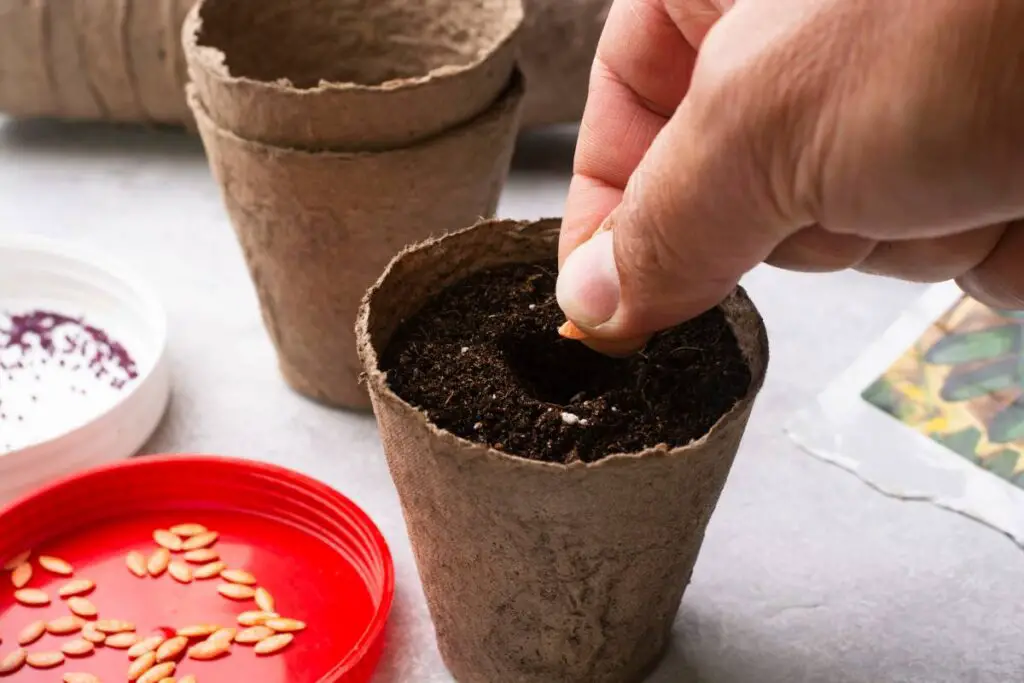
Understanding different local climates and growing conditions for cucumbers
The right time to sow seeds depends on the climate of your living region.
The ideal time for sowing the cucumber seeds in most areas is spring, when the soil starts warming up.
You can also start them indoors 4-6 weeks before the last frost and shift them outside after 2-3 weeks of the last frost.
Though cucumbers are easy to grow, they need a suitable climate for adequate growth.
Local climate can differ based on your living area, and the growing conditions must be adjusted if unsuitable for the cucumbers.
Here are some different climatic conditions and the chances of growing cucumbers:
Tropical climate
You should start sowing seeds in the early winter if you are from a tropical climate.
Tropical climates are warm enough to give your cucumbers the ideal environment to grow and thrive.
The perfect thriving temperature for the cucumbers is between 75 and 85°F.
Let them have 6 to 8 hours of sunlight, weekly watering with 1 inch of water, and weekly feeding with a liquid fertilizer.
If the temperature crosses 95°F and the sunlight feels intense, increase the watering and protect your plant from the intense sunlight.
Dry climate
If you belong to a dry climate, the problem with planting cucumbers is that they can turn bitter.
In a region with a dry climate, the cucumbers can dry out faster.
So, you must take care of the soil and the watering requirements.
Increase the amount to 2 inches, or increase the frequency from once a week to 2-3 times.
When you give them water to keep the soil moist, ensure it does not feel too soggy or damp.
Temperature climate
I am from zone 7, with mild temperate climates. Cucumbers can grow well in this climate.
They will enjoy the full sun with some shade as it can be intense in the afternoon during such climates.
Let the cucumbers have at least 6 to 8 hours of sunlight daily.
Some varieties will need more, and some will need less. Adjust the sunlight accordingly.
Give them 1-2 inches of water every week and fertilize them weekly.
How to determine the ideal planting time for cucumber seeds based on zones?
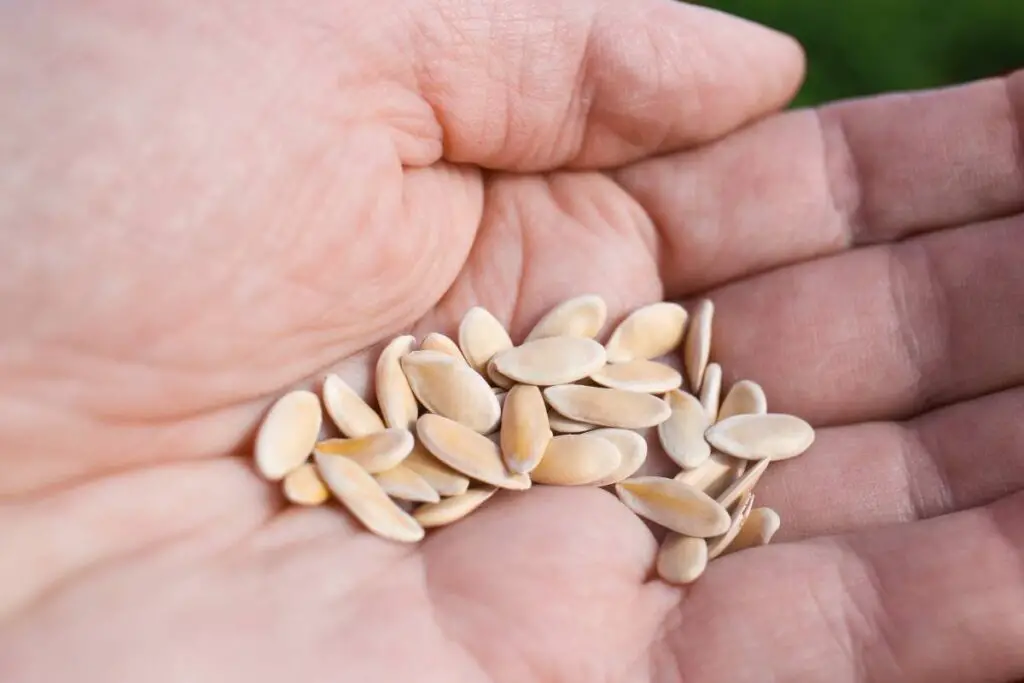
There are several zones, and whether the cucumbers can grow ideally in your area depends on the weather conditions of your zone.
For example, if you are from colder zones (2-5), the cucumbers must be sowed and grown indoors in containers.
But in the warmer zones (7-11), you can directly sow them in the ground.
To determine the ideal planting time for the cucumber seeds in your garden, you must first learn the temperature of your zone, the soil temperature, and the last frost date in your area.
I belong to USDA Zone 7. The last frost date is late March to mid-April, and the first is October 30.
I prefer planting the seeds outside when the soil starts warming up from April to May and rises to 60°F.
I sow the seeds between late spring and early summer from April to June.
Wait for the soil temperature to warm and let the danger of the last frost date in your region pass.
If you don’t want to wait or belong to a colder zone, start sowing the seeds indoors in pots 3-4 weeks before your decided planting date or 4 to 6 weeks before the last frost.
After the last frost has ended, after 2-3 weeks, bring the seedlings outside.
Choosing the suitable cucumber seed variety for your region and growing conditions
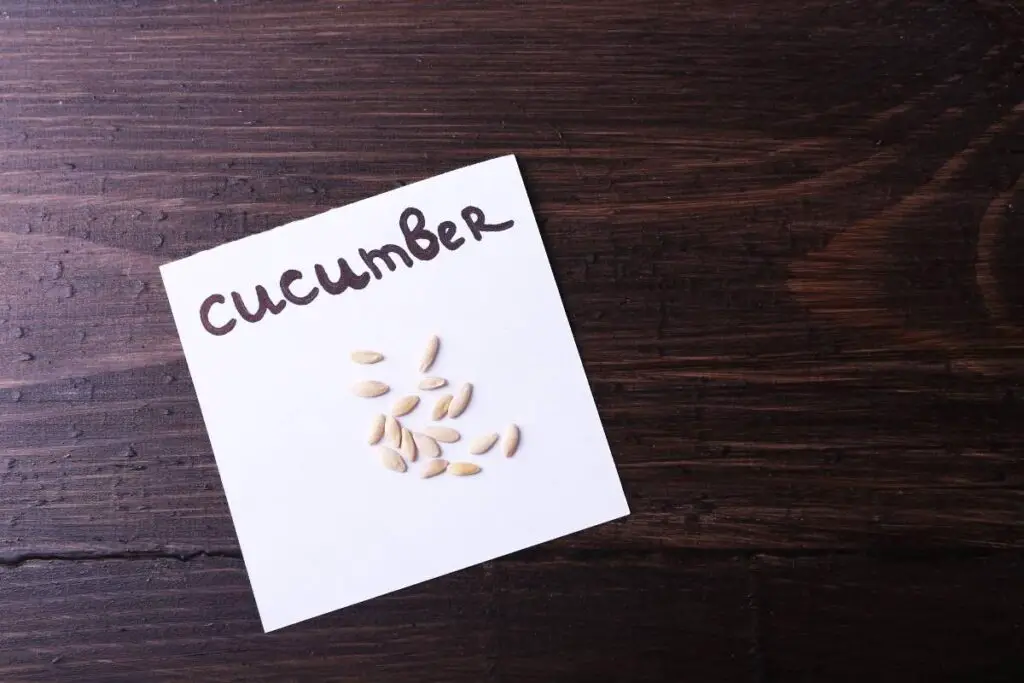
There are no specific cucumber seeds to choose from based on the zones.
All types of cucumbers can produce seeds, and most of them can thrive in zones 4 through 11.
The type of cucumber variety you choose depends on your intended usage and preferred texture and flavor.
So, focus on their growth habits and conditions for successful development.
The cucumbers can be grown from zones 4 to 12. If you are from a cold region, start growing them indoors and transplant them when the soil temperature warms up.
If your zone is warmer, directly sow them outside.
Here are some of the favorites I grow from seeds for my region:
Marketmore 76
Marketmore cucumber variety is an excellent slicing cucumber variety that can tolerate some cold in USDA zone 7.
This famous heirloom cultivar has high disease resistance from powdery and downy mildew, leaf spot, and mosaic virus.
Dr. Henry Munger initially made these deep green, slender, and thick-skinned cucumbers at Cornell University in 1968 and released them as Marketmore 76.
These cucumbers measure 8 to 9 inches long and mature after 67 days of planting.
The cucumbers are sweet and crunchy and contain a small seed cavity. You can use them for both slicing and pickling.
Looking for gardening supplies? We have tested 100's of products before recommending them to you guys. Check out our best pick below:
| Image | Gardening Supplies | Best Price? |
|---|---|---|
 Top
Top Top
Top | Raised Garden Bed Kit | Check On Amazon |
 | XLUX Soil Moisture Meter, Plant Water Monitor, Soil Hygrometer Sensor for Gardening, Farming, Indoor and Outdoor Plants, No Batteries Required | No Results |
 Top
Top Top
Top | 82 Pcs Garden Tools Set and Extra Succulent Tools Set | Check On Amazon |
 | Joeys Garden Expandable Garden Hose with 8 Function Hose Nozzle, Lightweight Anti-Kink Flexible Garden Hoses, Extra Strength Fabric with Double Latex Core, (50 FT, Black) | No Results |
 Top
Top Top
Top | Dual Chamber Compost Tumbler | Check On Amazon |
 Top
Top Top
Top | Sunnyglade Plant Stakes | Check On Amazon |
 Top
Top Top
Top | Organic Cold Pressed Neem Seed Oil | Check On Amazon |
 Top
Top Top
Top | Mighty Mint Gallon :-Insect and Pest Control Peppermint Oil | Check On Amazon |
 Top
Top Top
Top | Scotts DiseaseEx Lawn Fungicide | Check On Amazon |
 Top
Top Top
Top | Jacks Classic 20-20-20 All Purpose Fertilizer | Check On Amazon |
 Top
Top Top
Top | 30,000 Seeds Pollinator Attracting Wildflower Mixture | Check On Amazon |
 Top
Top Top
Top | Survival Vegetable Seeds Garden Kit-Over 16,000 Seeds | Check On Amazon |
Homemade pickles
These cultivars are also known as Southern Homemade Pickles.
This bush variety produces 5 to 6 inches of cucumbers.
Their texture and crispiness make them a popular choice.
After sowing, they become mature after 55 to 60 days.
Sweet slice
These cucumbers are a hybrid cultivar 10-12 inches long.
They are crispy, tender with thin and dark green skin.
These sliced cucumbers have a mild flavor with no bitterness.
Once sown, they become ready for harvest after 55 to 62 days.
Lemon cucumber
The lemon cucumbers are a perfect variety to add uniqueness and color to the vegetable garden.
As the name suggests, these cucumbers grow the size of a lemon with a yellowish-green tinge.
These cucumbers are ideal for all the zones, from 4 to 12.
The lemon cucumbers taste best when eaten fresh. Add them to the salads or as a garnish for drinks and dishes.
Preparing the soil for cucumber seed planting
The right kind of soil for the cucumbers is well-drained, nutrient-rich soil with a 6.0 to 6.5 pH level.
Before you sow the seeds directly or transplant them to the garden, prepare the soil and make it ideal for cucumber growth.
To prepare the soil, dig a few inches properly, break all the lumps, and add organic matter.
Keep digging and mixing the garden soil and organic matter to make the soil completely lumped-free.
If the soil has turned dark, it means it has become nutrient-rich.
Check the pH level once. If the soil is too acidic or alkaline, amend it before sowing the seeds.
You can go through our article, where we have shared the soil requirements and preparation for cucumbers in detail.
If you start the seeds in pots indoors, here are some mixes I prefer for cucumber seeds:
- 90% cocopeat and 10% compost
- 70% soil and 30% compost
Use a seed starting mix if you don’t want to make the soil mix.
Starting cucumber seeds indoors vs. outdoors – Proper planting techniques
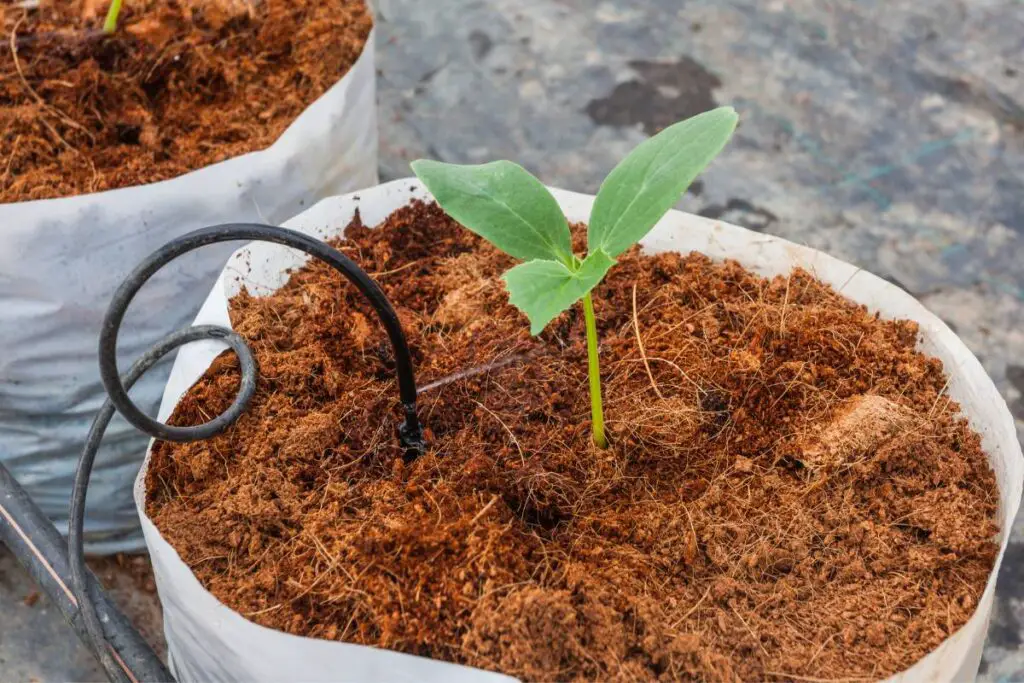
When to plant the cucumber seeds depends on where you want to start because seed sowing times indoors and outdoors are slightly different.
This section shares the sowing techniques of cucumber seeds indoors and outdoors with proper spacing and depth and how to transplant the indoor seedlings.
Indoor seed sowing and transplanting outdoors
If you are starting the seeds indoors, sow them in the pot 4 to 6 weeks before the last frost ends.
The cucumber seeds can germinate after 4 to 10 days of sowing.
Here are the planting techniques to sow cucumber seeds indoors:
- Before sowing them, soak the seeds in lukewarm water for 8 to 10 hours or room temperature water for 18 to 24 hours.
- All the seeds may not germinate. So, you must sow enough seeds to select the best seedlings and remove the others.
- You can pre-germinate the seeds. For that, wrap the seeds lightly in a paper towel, place them in the pot, add some water, and cover the pot with plastic. After some days, the seeds will have roots.
- Take a pot and fill it with a seed-starting soil mix.
- Sow one seed per pot around ½ to 1 inch deep for adequate results. Plant many seeds 4-6 inches apart if you use a tray.
- Ensure the indoor temperature is 70°F during the day and 60°F at night.
- Place the cucumber seeds next to sunny windows, but protect them from the intense sunlight.
- Water the soil to keep it moist, not wet or soggy.
- The seeds will germinate after 8 to 10 days.
After germination, thin out the cucumbers when the seedlings reach 4 inches by accepting only the healthiest ones to move out.
Wait for the weather to warm up before transplanting the cucumber plants outside.
4 weeks before the last frost in spring, warm up the soil by covering them with plastic or plastic tunnel.
Transplant the seedlings 2-3 weeks after the last frost date.
The best option is to wait until the soil temperature rises to 60-70°F in the morning and 64°F.
Begin to harden the seedlings 1-2 weeks before transplanting so they do not face any outside issues.
The seedlings must be at least 4 inches tall and have some leaves, which should be seen after 3-4 weeks of germination.
For transplanting the seedlings outside, find a place that can receive at least 6 to 8 hours of sunlight per day.
You can shift the seedlings in a bigger pot or plant them in the garden.
The base of the stem should be at the same level as the soil. For leggy stems, bury the stem up to the first leaf sets and press it in place.
Add compost to the soil before transplanting, make a big hole to fit the root ball, remove the seedling carefully from the pots, and plant them in the hole.
Cover the remaining roots adequately and water the plants.
After a month, add some organic fertilizer like compost, sea meal, or bone meal.
After 4-6 weeks, fertilize them weekly with a liquid fertilizer.
Direct seed sowing outdoors.
For directly sowing the seeds outdoors, you need to start sowing after you start them inside.
The best time to plant the seeds outside is 2-3 weeks after the last frost date in spring when the soil temperature rises to 65 to 70°F.
Soak the seeds with lukewarm water for 8 to 10 hours or room temperature water for 12 to 24 hours.
Find a proper planting site for sowing the seeds. The cucumbers need well-drained soil with a slightly acidic pH level.
Till the soil, remove the weeds, and add some compost to it to improve drainage and fertility. Moisten the soil properly.
Sow the seeds ¾ to 1 inch deep by maintaining the following distance:
- For rows – Sow the seeds 4 to 6 inches apart in rows 3 to 5 feet apart.
- For the mounds – Make small hills 1 to 1.5 feet in diameter and a few inches high. Space the mounds 1 to 2 feet apart and sow 2-3 seeds per mound.
- For the support structures – Sow 2-3 seeds per foot.
Maintain moist soil until you see the seeds sprouting.
When the seeds develop into seedlings, add a layer of mulch on the topsoil to prevent weeds and keep the soil warm and moist.
After the sprouting, water the plant with 1 inch of water per week. After 4-5 weeks, fertilize the plant with a liquid fertilizer.
Maintaining proper soil moisture and fertilization for healthy cucumber growth
If you enjoy your cucumbers growing, you would want to keep them growing like that. But for that, proper care is needed.
You must ensure they receive at least 6 to 8 hours of sunlight daily.
Along with that, watering and fertilizing at the right time is necessary.
Now, how do you do that correctly?
Here’s what I do.
Checking the soil moisture
I check the soil regularly and poke my fingers inside the soil around 1 inch.
If the top 1-inch feels dry, I apply 1 inch of water. It is my weekly watering schedule.
If the soil is dry, I recheck after some more days.
While watering the plants, I pour water at the soil level and avoid sprinkling them in the leaves.
Since they will be under direct sunlight, water droplets can magnify the sun’s intensity, leading to sunburns.
For the best results, you can use drip irrigation.
Fertilizing
Once the plant starts growing, I apply liquid fertilizers every 1-2 weeks.
If you use time-release, apply them every 1-2 months.
For the best results, every 2 weeks, I provide the plants with some organic food and spray them with mild liquid fertilizer as a foliar spray when the flowers appear.
The leaves can immediately absorb the nutrients and encourage vigorous growth.
Common pests and diseases that affect cucumber plants and how to prevent them
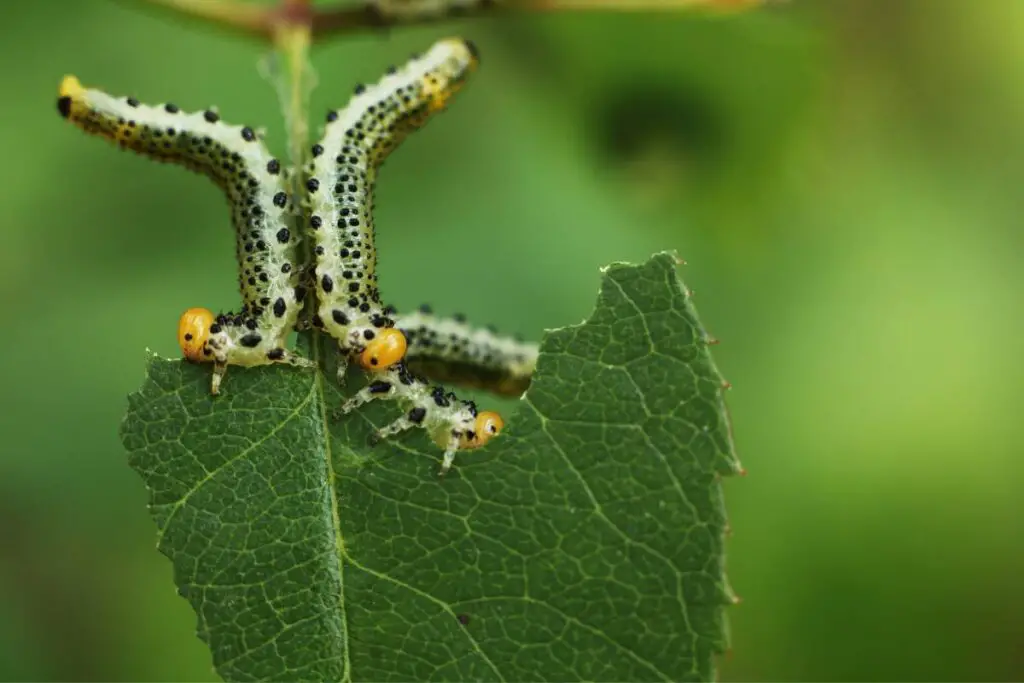
While growing cucumbers, you will have to deal with many pests and diseases if you do not care for them.
Below are some pests and diseases I have encountered in some of my cucumber plants:
Aphids
Damp soil can attract aphids. Applying a force of water can dislodge the aphids from their place and remove them from the plant.
Wash off the water as per the plant’s need early during the day.
Check the plant closely for any further signs of aphids, like gray-brown or bloated parasitized aphids or alligator-like larvae of lady beetles or lacewings.
Red spider mite
The pests are tiny, sap-sucking pests attracted by sweltering and dry conditions.
When they attack your plant, there will be a mottled appearance, leading to defoliation.
If you spot any such bugs, spray some neem oil or SB Plant Invigorator.
The Invigorator can act as an insecticide, pesticide, and foliar feeding.
When the temperature rises to 61°F, sprinkle some nematode parasite Phytoseiulus persimilis on the leaves.
Then spray some soft water on the leaves to increase humidity and moisten the soil.
Whitefly
Due to warm temperatures, these pests are common in cucumber plants, especially in greenhouses.
These can release honeydew and make the leaves sticky, leading to black mold.
To tackle these flies, you can spray neem oil. Neem oil can be applied to treat most pests and diseases.
But it should be done in the evening when the sunlight does not fall on the plant.
Besides this, you can also use organic insecticides like natural pyrethrum to control them.
Powdery mildew
Powdery mildew is a fungal disease that occurs during humid and damp conditions.
You can identify it when the leaves have some white powder-like marks. Over time, it can distort the leaves and the plant.
To fight this, spray neem oil on the leaves. Maintain proper distance between the leaves to increase the airflow and reduce humidity.
Remove the affected parts from the plant whenever you spot them.
Cucumber mosaic virus
The disease is easy to identify because it will make a unique, yellowish mosaic pattern in the leaves.
When the disease attacks, the plant stops flowering, and the cucumbers become hard, small, and inedible.
Aphids spread the disease. So, fight aphids to get rid of the disease.
Spray neem oil or wash your plants with a force of water.
Seasonal planting and care guide for cucumber seeds based on different USDA zones
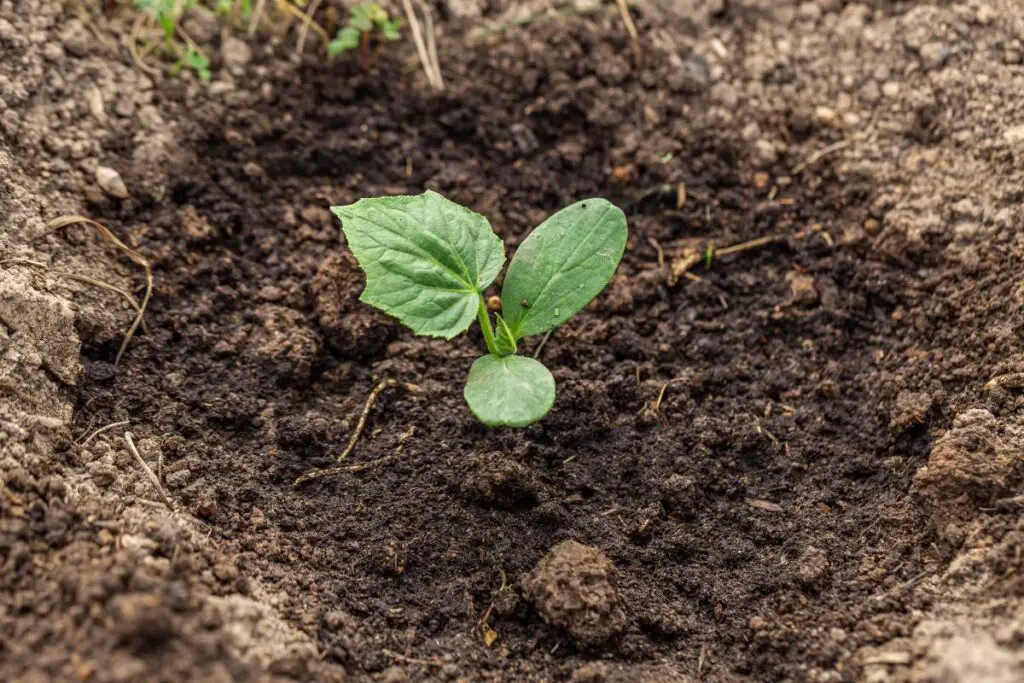
| Zones | Avg. Last frost dates | Planting dates |
|---|---|---|
| Zone 10 | January 30 | February 15 to March 15 |
| Zone 9 | February 8 | February 15 to April 1 |
| Zone 9 | February 18 | February 15 to April 15 |
| Zone 9 | February 28 | March 1 to April 15 |
| Zone 8 | March 10 | March 15 to April 15 |
| Zone 8 | March 20 | April 1 to May 1 |
| Zone 7 | March 30 | April 10 to May 15 |
| Zone 6-7 | April 10 | April 20 to June 1 |
| Zone 5-6 | April 20 | May 1 to June 15 |
| Zone 4-5 | April 30 | May 15 to June 15 |
| Zone 4 | May 10 | May 20 to June 15 |
| Zone 3 | May 20 | June 1 to June 15 |
| Zone 2 | May 30 | June 5 to June 15 |
| Zone 1-2 | June 10 | June 10 to June 15 |
This table roughly estimates different zones’ planting dates based on the last frost date.
Before you follow this table, consult your region’s temperature, zones, and last frost dates.
The last frost date may differ in your zone from those mentioned in the tables.
Care guide for cucumbers
Here are some simple steps to care for the cucumbers and encourage good growth and development:
- Start seeds inside 4-6 weeks before the last frost date. Do outdoor sowing 2-3 weeks after the last frost date. Indoor sowing is preferred if you are from colder zones. But in the warmer zones, you can always directly sow them in the ground.
- If you have started cucumber seeds indoors, transplant the seedlings outdoors after 2-3 weeks of the last frost date. Whether transplanting or directly sowing, the soil temperature must be 70 to 75°F.
- Plant the cucumbers in a place where they receive sunlight for 6 to 8 hours of sunlight. 8 to 10 hours of sunlight would be best for the best results, given moderate sunlight.
- When seedlings appear, maintain evenly moist soil with 1 inch of water per week. If the weather is hot and dry, increase the amount to 2 inches or the frequency to 2-3 times per week.
- The best way is to check the moisture level with your finger before watering. Whenever the top few inches feel dry, water the plant. Water slowly in the morning or early afternoon, and avoid overhead watering.
- Apply a 1-inch layer of mulch to help retain the moisture.
- Plant the seeds or seedlings in soil that is well-drained, loamy, and contains a pH level between 6.0 and 6.5.
- If you have added organic matter before planting, side-dress is enough with compost manure.
- When flowers appear, apply liquid fertilizer weekly. If you are a time-release lover, feed the plant once a month.
- If you have limited space, put up a trellis and train your cucumber vines to grow up the trellis.
- After 50 to 70 days, check the cucumbers to see if they are ready for harvest. Firm, green cucumbers with bumpy textures are mature cucumbers. Harvest them on time to prevent bitterness.
Final thoughts
The right time to plant seeds depends on where you want them to start. If you want to start them indoors, sow them in pots 4-6 weeks before the last average frost date. When the seedling appears, care for them well and allow the temperature to warm up. 2-3 weeks after the last frost date, transplant the seedlings outside.
If you want to sow the seeds outdoors directly, you must start much later. Sow the seeds directly 2-3 weeks after the last frost date. Different zones have different climatic conditions. Belonging from zone 7, I directly sow the seeds from May to June. To care for the plant, moisten the soil, add some organic matter after 30 to 35 days of germination, and start weekly fertilization when flowers appear.
Check for pests and diseases and fight them to stop spreading. You can use neem oil every 15-20 days. It can keep pests and diseases at bay and maintain adequate humidity.
What do cucumber seedlings look like?
The first two leaves are called seed leaves. They will be oval and slightly pointy at the leaf tips. After that, any leaves growing are called true leaves.
When to repot the cucumber plants?
Cucumbers must be repotted if you grow them in pots because they are creeping vines and can spread quickly. When the seedlings become the same size as the original pot, change the pot and repot the plant.
Reference: Wikipedia Germination

